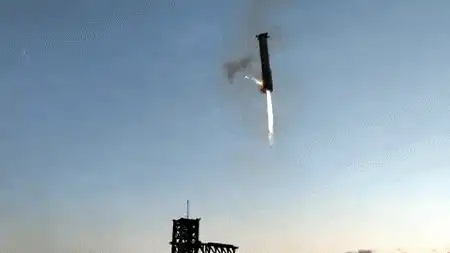Updated 13 October 2024 at 20:27 IST
SpaceX's Starship Rocket Successfully Caught by Launch Tower in Historic Test Flight
SpaceX successfully launched its Starship rocket, catching the booster with mechanical arms, marking a significant milestone in reusable rocket technology.
- Science News
- 3 min read

On Sunday, SpaceX achieved a significant milestone by launching its enormous Starship rocket, showcasing its boldest test flight to date. The towering rocket, reaching almost 400 feet (121 meters) in height, lifted off at sunrise from a launch site at the southern tip of Texas, near the Mexican border. The mission aimed to demonstrate the company's capability to catch the returning booster back at the launch pad using mechanical arms.
A Historic Launch
This flight marked a pivotal moment in SpaceX's ongoing quest for reusable rocket technology. Unlike previous Starship missions, which ended in destruction shortly after liftoff or during splashdowns in the Gulf of Mexico, this test aimed for complete recovery. The last flight in June was regarded as the most successful to date, completing its mission without exploding but failing to achieve booster recovery.
A Bold Challenge
SpaceX founder and CEO Elon Musk significantly increased the stakes for this flight. The first-stage booster returned to the launch pad just seven minutes after takeoff, landing gently thanks to the launch tower's massive metal arms, referred to as “chopsticks.” The successful catch was met with elation among SpaceX employees, who celebrated the moment. “The tower has caught the rocket!!” Musk announced via X, echoing the excitement felt at the launch site.
Engineering Marvel
“Even in this day and age, what we just saw is magic,” said Dan Huot, a SpaceX official who witnessed the landing. “I am shaking right now.” Kate Tice, another SpaceX representative, added, “Folks, this is a day for the engineering history books.”
Advertisement
Real-Time Decision Making
The landing decision rested with the flight director, who evaluated conditions in real time. Both the booster and the launch tower had to be in stable condition for the catch to proceed. Fortunately, everything aligned, allowing for the successful recovery, which prevented the booster from ending up in the Gulf like previous missions.
Completing the Mission
Once the booster was secured, the retro-looking stainless steel spacecraft continued its trajectory, targeting a controlled splashdown in the Indian Ocean, where it would ultimately sink after completing its mission. The entire flight duration was expected to last just over an hour.
Advertisement
Looking Ahead
This test flight is a culmination of SpaceX's efforts to enhance the performance of its rockets. After the June flight, which saw parts detach during ascent, the company upgraded its software and reworked the heat shield, improving thermal tiles to withstand the rigors of flight.
SpaceX has successfully recovered the first-stage boosters of its Falcon 9 rockets for nine years, landing them on floating platforms or concrete slabs far from the launch sites. In contrast, the Starship booster was successfully captured back at the launch pad, paving the way for future missions. Musk aims to utilize this technology for Starship, the largest and most powerful rocket ever built, featuring 33 methane-fueled engines. NASA has already ordered two Starships for lunar missions in the coming decade, while SpaceX envisions using Starship to send people and supplies to both the moon and Mars.
Published By : Garvit Parashar
Published On: 13 October 2024 at 20:25 IST
